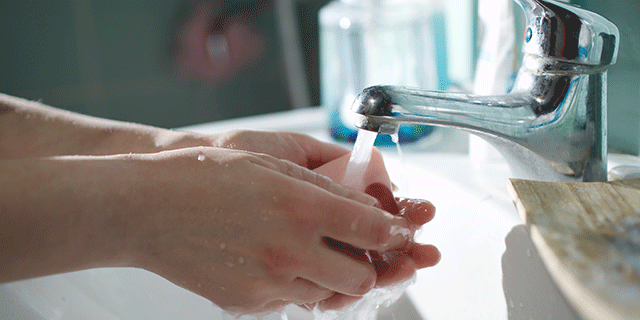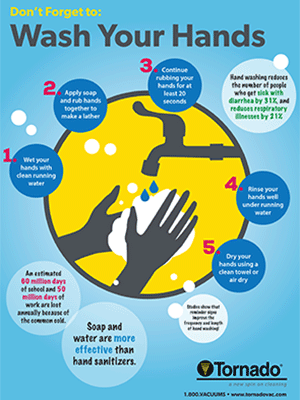The Costs of Handwashing Noncompliance—And How You Can Make a Difference
It is easy to understand the importance of hand washing as it relates to schools, healthcare or the food industry, but recent studies show it is an easy, inexpensive and effective way to increase productivity in a corporate setting as well.
Hand washing is the single most important way to prevent the spread of infection, according to the Centers for Disease Control. Despite this, who hasn’t seen someone leave a public restroom without using soap and water?
Studies have found hand washing compliance rates as low as 5 percent and as high as 50 percent. That means, conservatively, at least half of all people aren’t washing their hands correctly. Not washing hands isn’t just gross, it can also be costly.
Consider This:
Many industries pay a steep price for improper hand hygiene and the associated illnesses it can spread. For example:
- Healthcare: In the healthcare industry, hand hygiene can be a matter of life and death. Each year, more than 1.7 million Americans develop healthcare-associated infections (HAIs), which are infections acquired in the hospital while getting care for other issues. Nearly 100,000 of those people die, according to the CDC. HAIs cost the healthcare system between $35-45 billion annually.
- Public Education: Teachers average 5.3 illness-related absences per school year, and students average 4.5 days. That adds up to nearly 22 million school days lost each year due to the common cold, at a cost of $120 billion per year.
- Food Industry: Foodborne illnesses affect 48 million Americans a year at a cost of $51 billion in lost productivity and medical and death-related expenses. That doesn’t include the cost of loss of consumer confidence, expenses related to recalls or litigation, or the taxpayer burden for government health agencies that respond to outbreaks.
- Corporate America: Hundreds of thousands of workers develop illnesses on the job, resulting in $84 billion in lost productivity annually. Other indirect costs can include decreased morale, reduced quality of goods or services, and safety issues.
Facility cleaning managers and BSCs can help curb these costs by taking a few steps toward boosting hand hygiene compliance rates in their buildings.
1. Education
Besides simply not washing at all, other common mistakes people make when it comes to hand hygiene include not using soap, scrubbing the hands too briefly, and washing too infrequently.
Consider these findings from several studies:
- Only 33 percent of female and 8 percent of male students use soap when washing their hands after using the restroom.
- The average hand washing duration is less than 10 seconds.
- Approximately 65 percent of maintenance and construction workers and 47 percent of office workers wash their hands less than five times a day.
Proper hand washing is very straightforward and should follow these five steps:
- Wet hands with clean, running water.
- Apply soap. Rub into a lather.
- Scrub for at least 20 seconds.
- Rinse hands under running water.
- Dry hands with a clean towel or air dryer.
Reminding building occupants about proper hand washing can go a long way.
Studies show that reminder signs do improve the frequency and length of hand washing. Download our free hand washing poster. Incorporate your logo and hand it out to customers!
2. Products and Tools
The most important thing janitorial teams can do is provide building occupants with everything they need for proper hand hygiene. This starts with touch-free dispensers that reduce cross-contamination. Keeping them stocked and properly working should be priority.
Also, choose soap that occupants will use. The choice between liquid and foam soap is a matter of preference, so it may be worthwhile to conduct A/B testing or user surveys to find the most popular option.
Most facilities should offer gentle soaps rather than harsh antibacterial soaps, which aren’t always used correctly. In healthcare settings where antibacterial is required, offer lotion near every soap dispenser to prevent dry, chapped hands that can turn people off from washing.
Hand sanitizer is also important, providing a stop-gap measure that offers protection when soap and water aren’t available or convenient. Place alcohol-based, antibacterial sanitizer gel or wipes near high-touch points, workstations, or between large gaps in restrooms and handwashing stations.
Finally, provide solutions for drying, either air dryers or paper towels.
3. Other Ideas
Some facilities may be interested in taking and hand hygiene compliance a step further. In those cases, some manufacturers offer monitoring options.
One method is a tracer soap that’s sensitive to long-wave ultraviolet light. After washing with the products, hand are placed under a UV light to highlight missed areas with a blue glow. This helps the employee learn how to get a complete hand wash (and the information can be used to track employee compliance).
Other options are sinks with blinking lights that turn off after the appropriate length of wash time and alarms that sound if a nurse enters a patient’s room and doesn’t wash or sanitize their hands. These systems are often tied to chips in employee badges, giving managers the ability to track compliance.
What Can A Healthier Building Do For You?
Read the amazing results from these newly committed, eco-friendly facilities.
Increase Profits & Productivity with Your Equipment
Tornado Industries does more then sell equipment. We help solve facility cleaning challenges. Let’s talk about your cleaning challenges in person.





